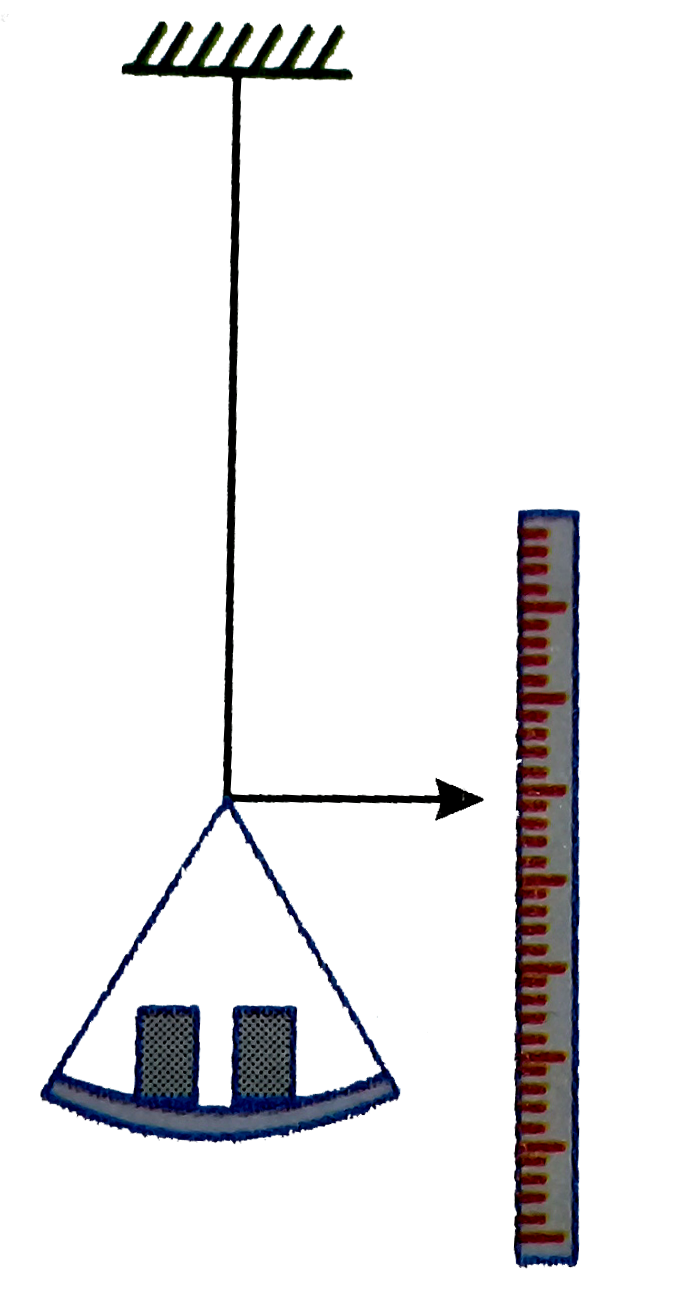In Searle's experiment to find young's modulus, the diameter of wire is measured as D=0.05cm , the length of wire is L=125cm , and when a weight , m=20kg is the put , extension in wire was found to be 0.100cm . Find the maximum permissible error in Young's modulus (Y).
(mg)(πd2/4)Y=9xl⇒Y=Y=mgl(π/4)d2x
(dYY)max=Δmm+Δll+2Δdd+Δxx
m=20.0kg⇒Δm=0.1kg
l=125m⇒Δl=1cm
d=0.050cm⇒Δd=0.001cm
x=0.100cm⇒Δx=0.001cm
(dYY)max=(0.1kg20.0kg+1cm125cm+2×0.0010.05cm+0.0010.100cmcm)×100%=6.3% .
Topper's Solved these Questions
- EXPERIMENTAL PHYSICSBOOK - RESONANCECHAPTER - EXPERIMENTAL PHYSICSEXERCISE - Exercise
12 Videos
- EXPERIMENTAL PHYSICSBOOK - RESONANCECHAPTER - EXPERIMENTAL PHYSICSEXERCISE - Exercise -1 PART
1 Videos
- ELECTROSTATICSBOOK - RESONANCECHAPTER - ELECTROSTATICSEXERCISE - HLP
39 Videos
- GEOMATRICAL OPTICS BOOK - RESONANCECHAPTER - GEOMATRICAL OPTICS EXERCISE - Advance level Problems
35 Videos
Similar Questions
In Searle's apparatus diameter of the wire was measured 0.05 cm by screw gauge of least count 0.001 cm. The length of wire was measured 110 cm by meter scale of least count 0.1 cm. An external load of 50 N was applied. The extension in length of wire was measured 0.125 cm by micrometer of least count 0.001 cm. Find the maximum possible error in measurement of Young's modulus.
View SolutionIn Searle's experiment, the diameter of the wire as measured by a screw gauge of least count 0.01cm is 0.050cm. The length, measured by a scale of least count 0.1cm, is 110.0cm. When a weight of 50N is suspended from the wire, the extension is measure to be 0.125cm by a micrometer of least count 0.01cm. Find the maximum error in the measurement of Young's modulus of the material of the wire from these data..
View Solution
Knowledge Check
In Searle's exp to find Young's modulus, the diameter of wire is mesured as D=0.05cm length of wire is L=125cm, and when a weight, m=20.0kg is put, extension in wire was found to be 0.100cm. Find maximum permissible percentage error in Young's modulus (Y)
A2.1%B3.2%C4.3%D5.4%In the Searle's method to determine the Young's modulus of a wire, a steel wire of length 156cm
and diameter 0.054cm is taken as experinmental wire. The average increases in length for 1.5kgwt is found to be 0.50cm. Then the Young's modulus of the wire isA3.002×1011N/m2B1.002×1011N/m2C2.002×1011N/m2D2.5×1011N/m2When a weight of 5kg is suspended from a copper wire of length 30m and diameter 0.5mm, the length of the wire increases by 2.4cm. If the diameter is doubled, the extension produced is
A1.2cmB0.6C0.3cmD0.15cm
In searle's experiment, the diameter of the wire, as measured by a screw gauge of least count 0.001 cm is 0.500 cm. The length, measured by a scale of least count 0.1cm is 110.0cm. When a weight of 40N is suspended from the wire, its extension is measured to be 0.125 cm by a micrometer of least count 0.001 cm. Find the Young's modulus of the meterial of the wire from this data.
View SolutionIn Searle's experiment, the diameter of the wire as measured by a screw gauge of least count 0.01cm is 0.050cm. The length, measured by a scale of least count 0.1cm, is 110.0cm. When a weight of 50N is suspended from the wire, the extension is measure to be 0.125cm by a micrometer of least count 0.01cm. Find the maximum error in the measurement of Young's modulus of the material of the wire from these data..
View SolutionIn Searl's experiment, which is used to find Young's Modulus of elasticity, the diameter of experimental wire is D=0.05cm (measured by a scale of least count 0.001cm) and length is L=110cm (measured by a scale of least count 0.1cm). A weight of 50N causes an extension of X=0.125cm (measured by a micrometer of least count 0.001cm). find the maximum possible error in the values of Young's modulus. Screw gauge and meter scale are free error.
View SolutionIn an experiment for measurement of young's modulus, following readings are taken. Load = 3.00 kg, length = 2.820 m, diameter = 0.041 cm and extension = 0.87. We shell determine the percentage error in measurement of Y.
View SolutionIn the experiment to determine Young's modulus of the material of a wire under tension
used in the arrangement as shown. The percentage error in the measurement
of length is a in the measurement of the radius of the wire is b and in the
measurement of the change in length of the wire is c. Percentage error in the measurement
of Young's modulus for a given load is

View Solution
